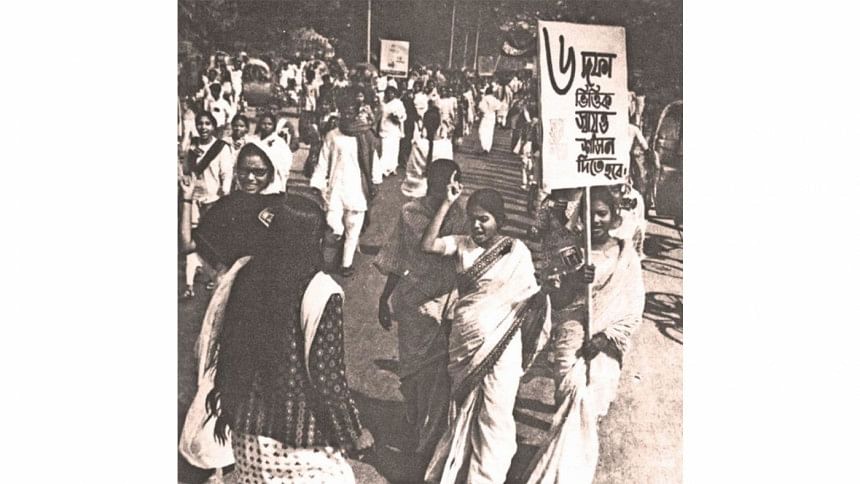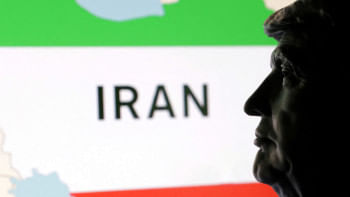A look back at the historic Six Point Movement

On June 7, 1966, in the then East Pakistan, a special protest day was observed in support of the Six Point Movement. The government of General Ayub Khan moved to suppress it with force. Huge demonstrations were fired upon by police claiming a number of lives. Large scale arrests followed. It is time once again to gratefully recall those intrepid Bangali nationalists whose sacrifices expedited our defiant march to full independence a few years later.
In so far as Bangladesh's socio-economic emancipation is concerned, the historic Six Point programme of the Awami League launched in 1966 is undoubtedly a milestone in the annals of our political progression. The Six Point Formula for regional autonomy was set out in a written statement, which was to have been placed before the Lahore Conference. It was published under the title "Six Point Formula-Our Right to Live" on March 23, 1966. It was presented as a statement of basic principles for a firm resolution of the country's inter-wing political and economic problems.
Before venturing to record the significance of the above historic document, let us look at the contents of the formulation. The Six Point, as formulated in the statement were:
Point 1: The Constitution should provide for a Federation of Pakistan, in its true sense, on the basis of the Lahore Resolution, and a parliamentary form of government with the supremacy of Legislature which would be directly elected on the basis of universal adult franchise.
Point 2: The federal government shall deal with only two subjects, vis: Defence and Foreign Affairs, and all other subjects shall vest in the federating states.
Point 3: Either of the two following measures (should be adopted) with regard to currency—(a) two separate, but freely convertible currencies for the two wings may be introduced, or (b) one currency for the whole country may be maintained. In this case, effective constitutional provisions are to be made to stop the flight of capital from East to West Pakistan. A separate banking reserve is to be made, and separate fiscal and monetary policy be adopted for East Pakistan.
Point 4: Power of taxation and revenue collection shall vest in the federating units and the federal centre shall have no such power. The federation shall have a share in the state taxes for meeting their required expenditure. The consolidated federal fund shall come out of a levy of a certain percentage of all state taxes.
Point 5: (1) There shall be two separate accounts for the foreign exchange earnings of the two wings; (2) the earnings of East Pakistan shall be under the control of the East Pakistan government, and that of West Pakistan under the control of the West Pakistan government; (3) the foreign exchange requirement of the federal government shall be met by the two wings either equally or in a ratio to be fixed; (4) indigenous products shall move free of duty between the two wings; (5) the Constitution shall empower the unit governments to establish trade and commercial relations and set up trade missions in, and enter into, agreements with foreign countries.
Point 6: A militia or paramilitary force shall be set up for East Pakistan.
It is relevant to recollect that the then "East Bengal" (present day Bangladesh) very rightly felt that it had not received a "fair deal" since the earliest period in Pakistan. There was an acute feeling of being discriminated against in the allocation of federal funds and foreign exchange, and in the matter of recruitment to public services by the central government. The writings of Bangali economists continued to highlight the discriminatory policies that had resulted in marked disparities in the economic developments of the two wings.
The main thrust of the Six Point scheme was to regionalise economic management. In fact, the essence of the scheme urged that the practical measures required to redress the disparity would need certain basic institutional changes. Those changes demanded the dismantling of the Central Planning Commission and replacing it with two powerful regional planning bodies, and the bifurcation of the ministries of finance and economic affairs. The idea was for regionalising economic management, i.e. transfer, to the regions the powers of taxation, of making fiscal and monetary policy, of planning and controlling resources, and of conducting foreign economic relations.
The "Six Point Formula" was indeed both demand and ground reality driven, as analyses had shown that the main instruments through which the transfer of resources had been made from the eastern wing to the western wing were control over foreign trade, foreign exchange and foreign aid. It was quite clear that federal control over economic management had to be countered and it was logically and manifestly demonstrated in the Six Point Formula. Quite expectedly, the ruling elite from the western wing was not prepared to relinquish the instruments through which they had been able to dominate the economy.
Pakistan's president General Ayub's reaction to the Six Point programme was to threaten repression with the use of force. He labelled the programme a scheme for secession and declared that he would respond to it "with the language of weapons". The Awami League decided to propagate the Six Point amongst the people and this inspired a tremendous mass movement to grow in its support. On April 18, 1966, Bangabandhu was arrested under the Defence of Pakistan Rules.
General Ayub Khan was removed from office by the mass upsurge of 1969. On March 29, 1969, General Yahya Khan was sworn in as Chief Martial Law Administrator and on assumption of office, committed himself to the transfer of power to the elected representatives of the people. National elections were held on December 7, 1970 in which the Awami League won 167 out of 169 seats in East Pakistan in a house of 313 seats. An overwhelmingly decisive election result gave an absolute majority to the Awami League and was a clear verdict in favour of the party's Six Point programme.
It is pertinent to recollect here that in June 1970 Bangabandhu had stated clearly that the elections would be a referendum on the Six Point. The popular verdict was decisive. Bangabandhu had to announce that the Six Point were now the property of the people and that he had no authority to compromise on their substance. This was so because there was a so called polite invitation from the military junta to discuss the substance of the Six Point, and Bangabandhu and the Awami League were not prepared to make any concession.
In a mammoth public meeting in January 1971, all elected members of national and provincial assemblies along with Bangabandhu and other leaders took an oath that they would not compromise on the Six Point. This was inevitable because at this time, Bengali nationalism was recording its voice and Sheikh Mujibur Rahman was the leader who had been marked to carry the struggle to its conclusion.
The military junta of Pakistan, in 1971, was not amenable to reason and were definitely blinded by ignorance and prejudice. It is thus no wonder that they did not come to terms with the Six Point, although according to even economists of moderate competence, the Six Point Formula was of benefit to the richest regions of West Pakistan. The refusal of the military government to concede to the logical demands resulted in the commencement of the non-cooperation movement, and the brutal military crackdown thereafter and the subsequent war of liberation leading to the emergence of sovereign Bangladesh.
There is no denying that the Six Point Movement created an unprecedented political awakening that clearly indicated that East Pakistan was no longer open to the exploitation either of its resources or its share of external assistance. Politically speaking, the Six Point programme galvanised an entire population to seek real economic emancipation by means of total decentralisation of economic decision-making, to be based on the use of the region's own resources. It was, indeed, an unique resolve of our self-determination.
Muhammad Nurul Huda is a former IGP.

 For all latest news, follow The Daily Star's Google News channel.
For all latest news, follow The Daily Star's Google News channel. 



Comments